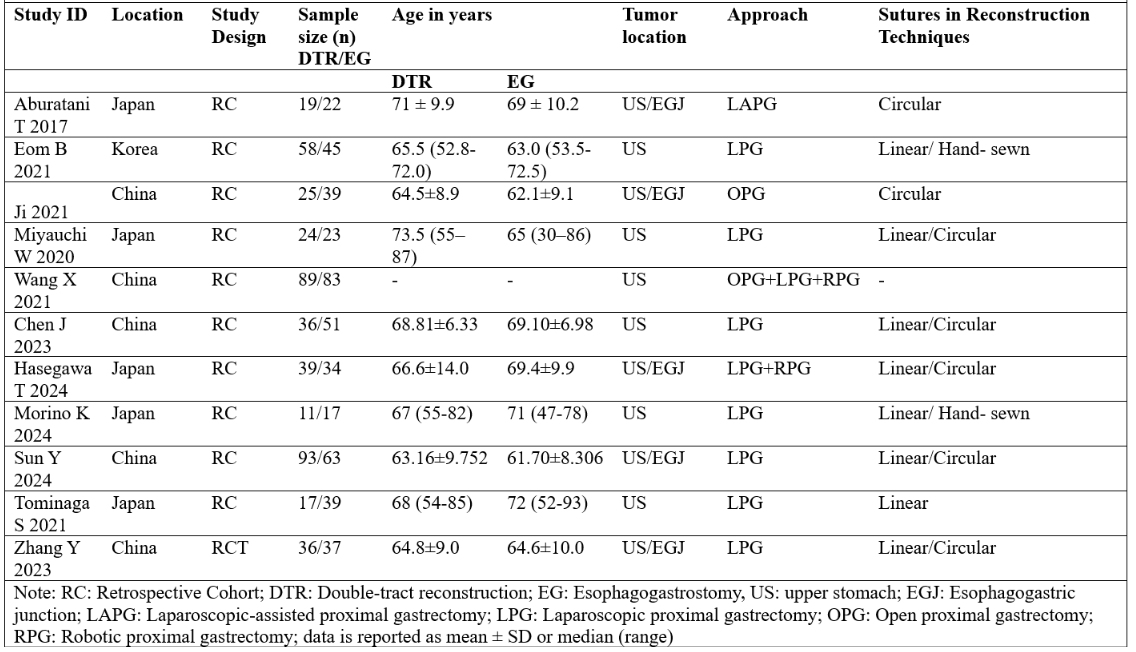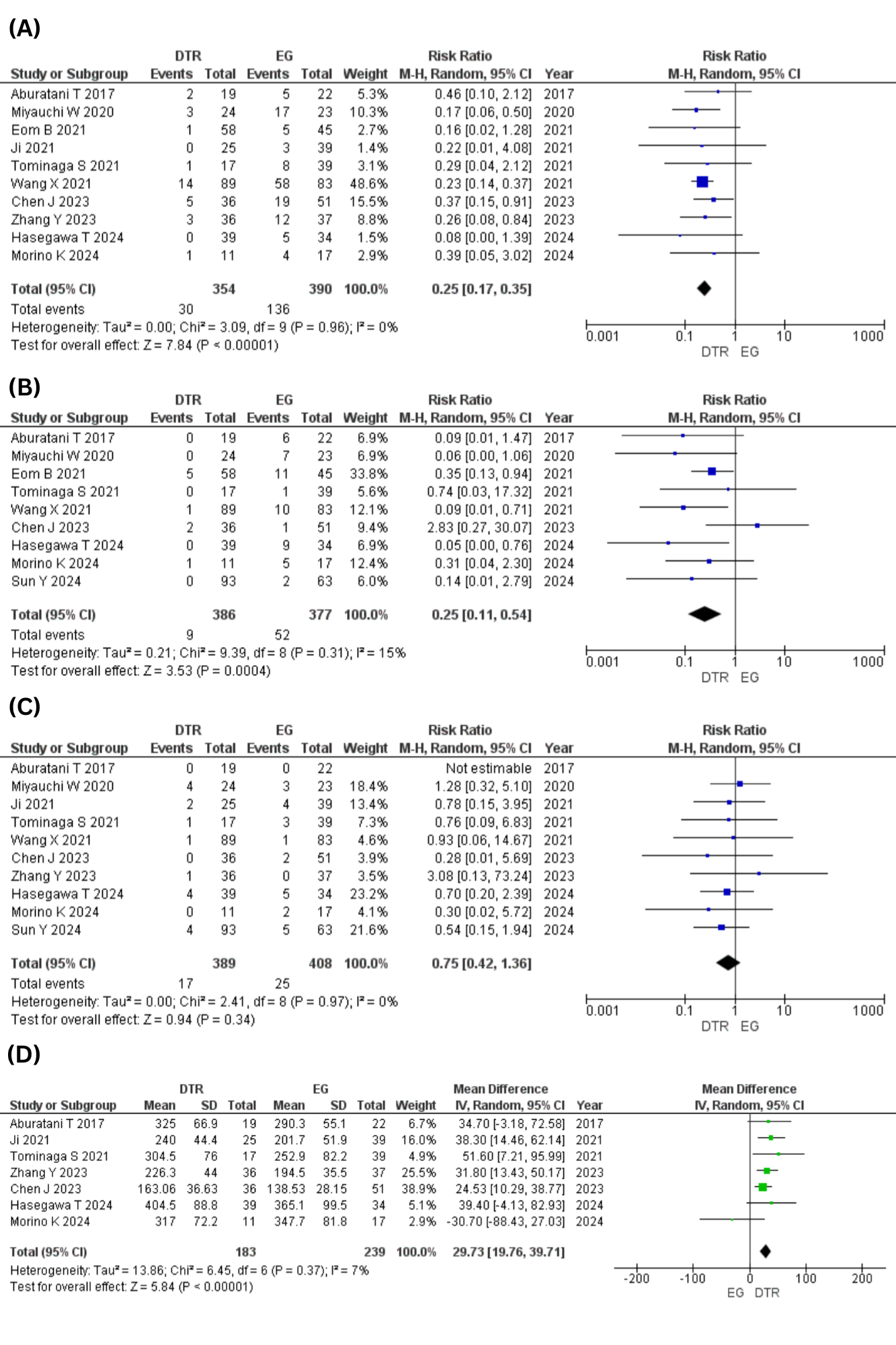Tuesday Poster Session
Category: Stomach and Spleen
P6313 - Double-Tract Versus Esophagogastrostomy Reconstruction After Proximal Gastrectomy: Which Method Wins on Outcomes? A Systematic Review and Meta-Analysis
Tuesday, October 28, 2025
10:30 AM - 4:00 PM PDT
Location: Exhibit Hall

Fariha Hasan, MD
Cooper University Hospital
Camden, NJ
Presenting Author(s)
Fariha Hasan, MD1, Zain Ul Abideen, MBBS2, Muhammad Hassan Waseem, MBBS3, Sania Aimen, MBBS4, Noor Ul Huda Ramzan, MD5, Prasun K.. Jalal, MD6
1Cooper University Hospital, Camden, NJ; 2King Edward Medical University, Lahore, Punjab, Pakistan; 3Allama Iqbal Medical College, Lahore, Punjab, Pakistan; 4Quetta Institute of Medical Sciences, Quetta, Balochistan, Pakistan; 5University of Texas Southwestern Medical Center, Dallas, TX; 6Baylor College of Medicine, Houston, TX
Introduction: Proximal gastrectomy (PG) is a treatment option for early-stage gastric cancer in the upper one-third of the stomach. The optimal reconstruction method after PG remains a topic of debate. This meta-analysis aimed to compare the surgical outcomes of the double-tract reconstruction (DTR) and Esophagogastrostomy (EG) reconstruction methods after PG.
Methods: Electronic databases like PubMed, Cochrane Central, and ScienceDirect were searched from inception till January 2025.This review adhered closely to the PRISMA (Preferred Reporting Items for Systematic Reviews and Meta-Analyses) guidelines. Risk Ratios (RR) and Mean Differences (MD) with 95% Confidence Intervals (CI) were pooled under the random effects model using the Review Manager software version 5.4.1 for the dichotomous and continuous outcomes. The primary and secondary endpoints of interest were reflux esophagitis, anastomotic stricture, anastomotic leakage, operative time (min), intraoperative blood loss (ml), and postoperative hospital stay (days). Quality assessment was done through the Cochrane Risk of Bias (RoB) 2.0 tool and the Newcastle Ottawa Scale. Publication bias was assessed visually through funnel plots and statistically through Egger’s regression test. Leave-one-out sensitivity analysis was conducted to assess the source of heterogeneity.
Results: Eleven studies pooling a total of 744 patients were included in this meta-analysis. DTR significantly decreased reflux esophagitis compared to EG (RR=0.25, 95%CI:[0.17,0.35]; p< 0.00001; I2=0%). DTR was also associated with a lower risk of anastomotic stricture (RR= 0.25; 95%CI:[0.11,0.54]; p=0.0004; I2=15%) and a longer operating time (MD= 29.73 min; 95%CI:[19.76,39.71]; p< 0.00001; I2=7%). Other outcomes including the anastomotic leakage (RR= 0.75; 95%CI:[0.42,1.36]; p=0.34; I2=0%), intraoperative blood loss (MD= 2.99 ml; 95%CI:[-5.00,10.99]; p=0.46; I2=0%), and postoperative hospital stay (MD= 0.33 days; 95%CI:[-0.60,1.27]; p=0.48; I2=47%) were comparable between the DTR and EG groups.
Discussion: The DTR group showed a lower risk of reflux esophagitis and anastomotic stricture with a longer operating time. Other outcomes including the anastomotic leakage, intraoperative blood loss and postoperative hospital stay were comparable between the two reconstruction techniques. These findings suggest DTR offers better functional outcomes and may be preferred for reducing postoperative complications.

Figure: Figure 1: Forest Plots for (A)Reflux Esophagitis (B)Anastomotic Stricture (C)Anastomotic Leakage (D)Operative Time

Figure: Figure 2: Baseline Characteristics of the Included Studies
Disclosures:
Fariha Hasan indicated no relevant financial relationships.
Zain Ul Abideen indicated no relevant financial relationships.
Muhammad Hassan Waseem indicated no relevant financial relationships.
Sania Aimen indicated no relevant financial relationships.
Noor Ul Huda Ramzan indicated no relevant financial relationships.
Prasun Jalal: AbbVie – Consultant. Gilead Sciences – Consultant.
Fariha Hasan, MD1, Zain Ul Abideen, MBBS2, Muhammad Hassan Waseem, MBBS3, Sania Aimen, MBBS4, Noor Ul Huda Ramzan, MD5, Prasun K.. Jalal, MD6. P6313 - Double-Tract Versus Esophagogastrostomy Reconstruction After Proximal Gastrectomy: Which Method Wins on Outcomes? A Systematic Review and Meta-Analysis, ACG 2025 Annual Scientific Meeting Abstracts. Phoenix, AZ: American College of Gastroenterology.
1Cooper University Hospital, Camden, NJ; 2King Edward Medical University, Lahore, Punjab, Pakistan; 3Allama Iqbal Medical College, Lahore, Punjab, Pakistan; 4Quetta Institute of Medical Sciences, Quetta, Balochistan, Pakistan; 5University of Texas Southwestern Medical Center, Dallas, TX; 6Baylor College of Medicine, Houston, TX
Introduction: Proximal gastrectomy (PG) is a treatment option for early-stage gastric cancer in the upper one-third of the stomach. The optimal reconstruction method after PG remains a topic of debate. This meta-analysis aimed to compare the surgical outcomes of the double-tract reconstruction (DTR) and Esophagogastrostomy (EG) reconstruction methods after PG.
Methods: Electronic databases like PubMed, Cochrane Central, and ScienceDirect were searched from inception till January 2025.This review adhered closely to the PRISMA (Preferred Reporting Items for Systematic Reviews and Meta-Analyses) guidelines. Risk Ratios (RR) and Mean Differences (MD) with 95% Confidence Intervals (CI) were pooled under the random effects model using the Review Manager software version 5.4.1 for the dichotomous and continuous outcomes. The primary and secondary endpoints of interest were reflux esophagitis, anastomotic stricture, anastomotic leakage, operative time (min), intraoperative blood loss (ml), and postoperative hospital stay (days). Quality assessment was done through the Cochrane Risk of Bias (RoB) 2.0 tool and the Newcastle Ottawa Scale. Publication bias was assessed visually through funnel plots and statistically through Egger’s regression test. Leave-one-out sensitivity analysis was conducted to assess the source of heterogeneity.
Results: Eleven studies pooling a total of 744 patients were included in this meta-analysis. DTR significantly decreased reflux esophagitis compared to EG (RR=0.25, 95%CI:[0.17,0.35]; p< 0.00001; I2=0%). DTR was also associated with a lower risk of anastomotic stricture (RR= 0.25; 95%CI:[0.11,0.54]; p=0.0004; I2=15%) and a longer operating time (MD= 29.73 min; 95%CI:[19.76,39.71]; p< 0.00001; I2=7%). Other outcomes including the anastomotic leakage (RR= 0.75; 95%CI:[0.42,1.36]; p=0.34; I2=0%), intraoperative blood loss (MD= 2.99 ml; 95%CI:[-5.00,10.99]; p=0.46; I2=0%), and postoperative hospital stay (MD= 0.33 days; 95%CI:[-0.60,1.27]; p=0.48; I2=47%) were comparable between the DTR and EG groups.
Discussion: The DTR group showed a lower risk of reflux esophagitis and anastomotic stricture with a longer operating time. Other outcomes including the anastomotic leakage, intraoperative blood loss and postoperative hospital stay were comparable between the two reconstruction techniques. These findings suggest DTR offers better functional outcomes and may be preferred for reducing postoperative complications.

Figure: Figure 1: Forest Plots for (A)Reflux Esophagitis (B)Anastomotic Stricture (C)Anastomotic Leakage (D)Operative Time

Figure: Figure 2: Baseline Characteristics of the Included Studies
Disclosures:
Fariha Hasan indicated no relevant financial relationships.
Zain Ul Abideen indicated no relevant financial relationships.
Muhammad Hassan Waseem indicated no relevant financial relationships.
Sania Aimen indicated no relevant financial relationships.
Noor Ul Huda Ramzan indicated no relevant financial relationships.
Prasun Jalal: AbbVie – Consultant. Gilead Sciences – Consultant.
Fariha Hasan, MD1, Zain Ul Abideen, MBBS2, Muhammad Hassan Waseem, MBBS3, Sania Aimen, MBBS4, Noor Ul Huda Ramzan, MD5, Prasun K.. Jalal, MD6. P6313 - Double-Tract Versus Esophagogastrostomy Reconstruction After Proximal Gastrectomy: Which Method Wins on Outcomes? A Systematic Review and Meta-Analysis, ACG 2025 Annual Scientific Meeting Abstracts. Phoenix, AZ: American College of Gastroenterology.
